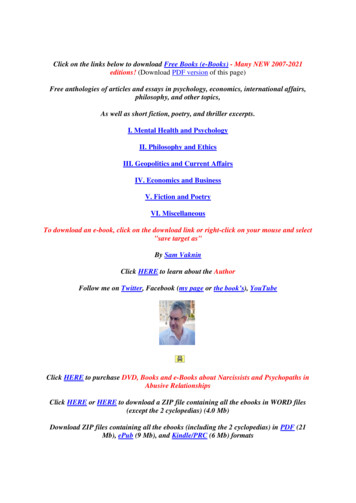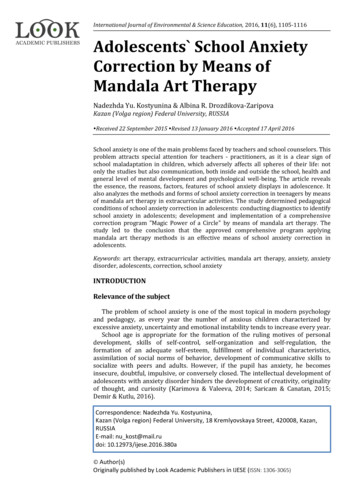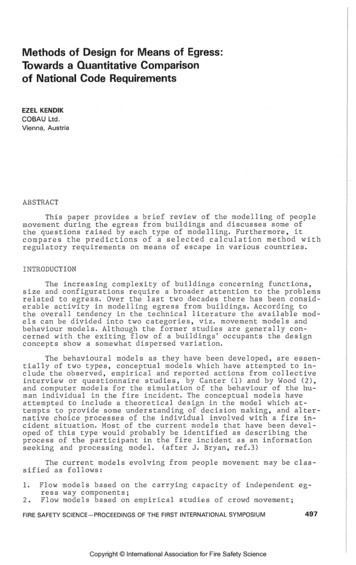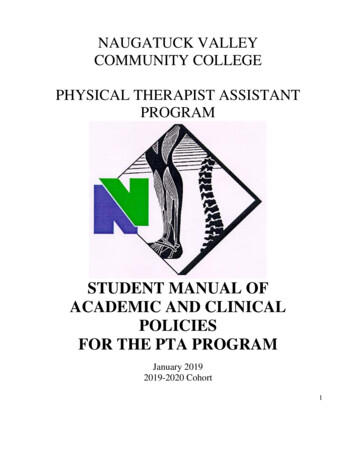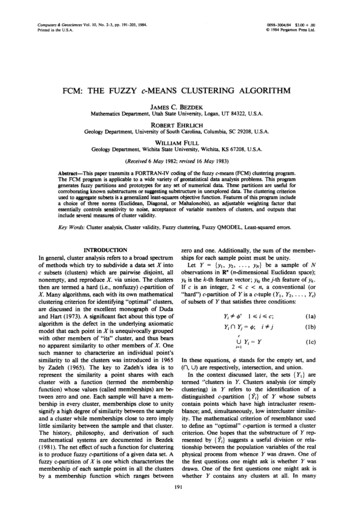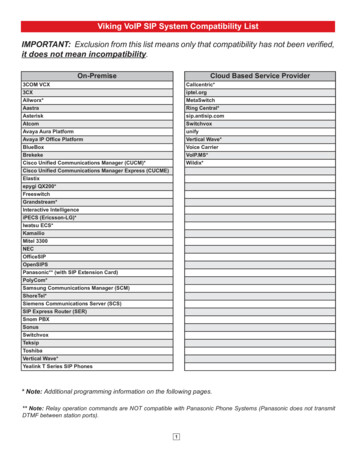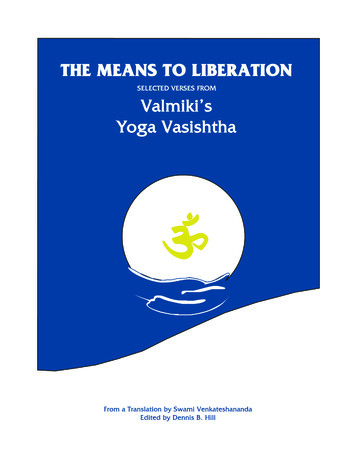
Transcription
THE MEANS TO LIBERATIONSELECTED VERSES FROMValmiki’sYOGA VASISTHAFrom a Translation by Swami VenkateshanandaEdited by Dennis B. Hill
PRODUCED BYDennis B. Hill2631 Marlee Dr.Turlock CA 95380U.S.A.All rights reserved. No part of the contents of this book maybe reproduced or transmitted in any form or by any meanswithout the written permission of the publisher from whichthe body text of this book was excerpted.Permission may be requested from:Swami Krishnananda, General SecretaryThe Divine Life SocietyP.O. Shivanandanagar - 249 192Distt. Tehri-Garhwal, U.P.Himalayas, INDIACredit:“Yoga Vashishta - An Introduction” first published bySwami Suryaprakash Saraswati, Yoga Magazine, July 2003.PRINTED IN THE UNITED STATES OF AMERICAFirst printing 1992Second Printing 2003Third Printing 2006
DedicationI dedicate this work to THIS;beyond which there isn’t, without which we aren’t,and within which the self-luminous Absoluteappears as the diversity.This work is dedicated to the Guru,who teaches usthrough silence, service, grace and reverencethat our very being is the supracausal divine presence.This work is dedicated to true love, serenity and delight,that spontaneously emergeswhen one is steady in the inner contentment.
Yoga Vashishtha – an IntroductionYoga Vashishtha, written by Sage Valmiki, is the spiritual teaching imparted by SageVashishtha to Sri Rama. In Balakand of Ramayana there is also a reference thatRama received spiritual instructions and guidance from his guru Vashishtha. Whilethe Ramayana relates Sri Rama’s adventures and the meaning of the different stagesof his life, Yoga Vashishtha relates the teachings which he received and describes thedifferent chapters in his spiritual evolution. Yoga Vashishtha is also known as theMaha Ramayana, the Uttar Ramayana and the Vashishtha Ramayana. We can alsocall it the ‘Behind the scenes Ramayana’, because it describes how Rama’s knowledge,wisdom and understanding evolved and progressed throughout the different stagesof his life.Yoga Vashishtha is an elaborate work, consisting of 32,000 verses and 64,000lines. It has been divided into six main chapters, which are the different stages ofspiritual evolution in the life of Sri Rama. The chapters are called prakaranas. Thefirst chapter is Vairagya Prakarana, in which Sri Rama experiences a very deep andintense dispassion and distaste for all worldly objects and pleasures. Although in SriRama’s case the desire for worldly objects was never described as being very intense,still it is the first stage of Sri Rama’s spiritual evolution and the first requirement inspiritual life. The second chapter is the Mumukshu Prakarana, which describes theintense desire for Self-realization that Sri Rama experiences. After achieving vairagya,after attaining the state of being different from the world, of not being involved butbeing more of an observer, then the next stage is changing the quality of the desiresfrom worldly to spiritual. That is the second stage of Sri Rama’s evolution.The third chapter is the Utpatti Prakarana in which Sri Rama learns from hisguru the origins of the world. It is deepening the understanding of why we getcaught up and involved with worldly objects and pleasures, and how those outsideobjects are identified in the mind.The fourth chapter is the Sthiti Ramayana in which, after having attained thatfirm understanding of the origin of the world process, Sri Rama sustains himself inthe Self, in Brahman. That is the time of spiritual enlightenment. The fifth chapter isthe Upasama Prakarana, which describes the deep peace that emerged from havingattained that spiritual enlightenment. The sixth chapter is the Nirvana Prakarana,which is the final liberation.Waking up from the dreamThe main theme of Yoga Vashishtha is that the soul is undergoing a dream fromwhich it must awake. This dream represents our association and identification withthe world. The fact that it is described as being a dream means that whatever is in ithas to be false. Nothing in a dream can be true. Waking up from that dream is theultimate goal, Self-realization.
ValmikiYoga Vashishtha has been written, not as straight dialogue between SageVashishtha and Sri Rama, but in the form of a story within a story within a story. It isnot a standard scriptural textbook. Our lives are also rather like a story within a storywithin a story. For example, a desire arises for a particular object. Then there is apursuit to obtain that object. If the object is attained, there is an elation, a happiness,that doesn’t last very long, as we know. Then there is a further desire for what weconsider to be a better object. Again there is another pursuit after that object. Butif the object is not obtained, there is frustration, anger, loss of mental balance, andthen, all of a sudden, out of nowhere guilt arises - “Why was I pursuing this objectin the first place?” But the desire for that object still remains along with the guilt.The mind that is feeling guilty for pursuing that object is the same mind that wantsto obtain that object. So there is mental conflict, confusion and no clarity.The first chapter has been called Vairagya Prakarana because until one cuts thatidentification with and desire for worldly objects, that fogginess will remain. Notuntil the fogginess disappears will mental clarity prevail and will one be able toevaluate, analyze and reflect on what the true aspiration is. While we are involvedin that desire, we cannot see what the real aspirations are and what we really wantto obtain, and there will be no real transformation in the quality of that desire.That is why Vairagya Prakarana has been described as the first chapter in Sri Rama’sspiritual evolution, and of course it applies to all aspirants. Once there is clarity, thencomes the second chapter, Mumukshu Prakarana, which is changing the quality ofthat desire to a higher nature, which is Self-realization.Sri Rama describes this in a very beautiful and simple way. If you pour waterinto a basket made out of straw, what will happen? The water will not remain inthe basket. All the water will permeate through and the basket will remain empty.The basket symbolizes the drive to indulge and involve oneself in worldly objectsand pleasures because there is a need for happiness and peace, the desire to obtainsomething, to achieve something, and to be stable in that happiness and inner peace.The pouring of water into the basket represents the effort, the purushartha, that onemakes in one’s life to obtain that something. But what happens? The fact that thewater permeates through the basket and leaves it empty means that no matter howmuch water you pour in, no matter how deep you go in that dream, the basket willalways remain empty. That is the transitory, short term and temporary nature of thehappiness and contentment derived from worldly objects.Imagine you are having a nightmare in which people are chasing you and you arerunning away. Suddenly the road splits into two. On one side people are still chasingyou, so you say, “I’d better not go in that direction and I cannot go back.” So whatdo you do? You either turn to the right and continue running in the same circle, oryou simply wake up and put an end to the dream. This waking up from the dream,which is described in Yoga Vashishtha, is the opening of the third eye. The third eye8
Yoga Vasisthais a symbol which represents discrimination, wisdom. It is that discrimination andwisdom which ultimately leads one to the experience of vairagya, of dispassion.Discrimination means knowing what is right and what is wrong, being able todifferentiate and to guide one’s life and efforts towards something everlasting, notsomething temporary which will disappear the moment you touch it. Applying thatdiscrimination then becomes dispassion. Dispassion is not something that can beapplied as an intellectual concept, rather it is a gradual process of transformationof the mind and of the nature of the mind, transformation of the desires and thequality of these desires. So, Yoga Vashishtha describes the spiritual aim as being thewaking up from that dream that we are going through.Sutikshna and AgastyaThe first story in the Vairagya Prakarana does not begin with Sage Vashishthaspeaking to Sri Rama, but with a very humble and modest Brahmin namedSutikshna who has gone to his guru, Sage Agastya, for spiritual guidance. WhenAgastya, knowing his disciple very well, asked him the cause of his confusion andgrief, Sutikshna said, “Tell me, is it the performance of one’s duty that will lead oneto liberation, to nirvana, to moksha, or is it the renunciation of everything, going tothe Himalayas and forgetting everybody and everything?”Sage Agastya replied, “Just as a bird flies on two wings, in the same way theaspirant flies up to the goal of self-realization, to liberation, on the two wings ofkarma and wisdom. So it is neither one nor the other but the blending of the two.That is the art which one has to learn to evolve in spiritual life.” Seeing that Sutikshnawas still confused, Agastya said, “I will tell you another story to help you understandbetter.”Agnivesya and KarunyaThe second story is about Karunya and his father Agnivesya. Once upon a timethere was a boy named Karunya who went to the gurukul at an early age and masteredthe Vedas and the Puranas and became a very knowledgeable person. After finishinghis training, he returned to his father’s home. Suddenly, one day he too becamedepressed and fell into a state of grief. Agnivesya went to him and said, “Tell me thecause of your grief.” Karunya replied, “I have been studying all this time, but still Ihave one question. It is mentioned in the scriptures that one will attain liberation, thatone will free oneself from the cycle of births and deaths, through the performanceof one’s duties. But at the same time it says that only through renunciation will oneattain this freedom. So what should one do?” Agnivesya replied, “I will tell you astory which will help you to understand this point perfectly.”9
ValmikiSuruchi and DevaduttaSo here is the third story, and the dialogue between Sage Vashishtha and SriRama has still not yet begun. Agnivesya began, “Once upon a time a beautifuldamsel named Suruchi was sitting on a mountain peak in the Himalayas, reflectingon life. All of a sudden she saw a messenger of Lord Indra’s flying by, so she calledhim and asked, “Where are you going?” He replied, “That is a very good question,let me tell you a story.”Devadutta and ArishtanemiOnce upon a time there was a king named Arishtanemi. After having performedhis kingly duties and having ruled the kingdom with authority, according to thescriptures, he had retired and passed on his kingdom to his son. For hundredsand hundreds of years he had practised severe austerities and meditations in theforest. Lord Indra was so impressed that he sent his messenger Devadutta to inviteArishtanemi to the heavens. So Devadutta went off in a chariot full of the mostbeautiful damsels and the most learned scholars to invite King Arishtanemi on afirst class flight to the heavens.Devadutta arrived in the forest where Arishtanemi was practising his meditation,and passed on Lord Indra’s invitation. Arishtanemi understood that he was beingoffered a reward for his good deeds, the fruits of his karmas. He said, “Tell me whatkind of fruits I will enjoy from these karmas in the heavens?” Devadatta replied,“According to the karmas one has performed in one’s life, the quality of the fruitwill vary. Due to this variety, there is jealousy amongst the enjoyers of the fruits.Therefore, once the bonus is consumed, you have to go back and pass throughanother stage of birth.”King Arishtanemi said very firmly, “No, I am not going with you. I am performingthese austerities to experience everlasting happiness and peace within, and to knowthat source, not to go through the same thing. Therefore, I’m not going with you.”Arishtanemi and ValmikiSo Devadutta returned in an empty flight, first class, and told Lord Indra whatArishtanemi had said. Lord Indra said, “Go back and take him to Sage Valmiki. TellSage Valmiki to instruct Arishtanemi in spiritual knowledge, to guide him and leadhim towards liberation, which is the reason why he is here.”Devadutta took King Arishtanemi to Sage Valmiki and when Arishtanemi sawValmiki, he understood that he had come to the right place. He said, “I wish you toinstruct and guide me, so that I can become free from these sorrows and miserieswhich I am unable to separate myself from alone.” At this point, Sage Valmiki beginsto tell King Arishtanemi the story of Yoga Vashishtha, the dialogue between SageVashishtha and Sri Rama.10
Yoga VasisthaFrom intellect to intuitionSo the introduction to Vairagya Prakarana contains many stories within stories.These stories have a twofold meaning. There is always a superficial meaning and atanother level a more spiritual and deeper understanding.In the first story Sutikshna approaches Agastya for spiritual guidance. Sutikshnameans subtle, sharp, and Agastya means the effulgent sun. The movement of Sutikshnatowards Sage Agastya represents the move of the intellect towards intuition. Anaspirant with the ability to move from intellect to intuition is considered to be thehighest type of aspirant. The scriptures say that intellect is considered to be a barrierin spiritual life, but this has to be understood properly. As the absence of intellect isnot the key to overcoming this barrier, the key has to be something associated withintellect.Intellect begins with the letter ‘I’. The purpose of intellect is also to serve ‘I’, so ifintellect is not the barrier directly, it is this ‘I-ness’ associated with the intellect whichbecomes the barrier. Intellect and ego, ‘I-ness’, have a very intimate relationship,even more intimate than the relationship between a husband and wife. The wayto transcend this barrier is therefore not to create an absence of intellect, but tochange the purpos
“Yoga Vashishta - An Introduction” first published by Swami Suryaprakash Saraswati, Yoga Magazine, July 2003. PRINTED IN THE UNITED STATES OF AMERICA First printing 1992 Second Printing 2003 Third Printing 2006. Dedication I dedicate this work to THIS; beyond which there isn’t, without which we aren’t, and within which the self-luminous Absolute appears as the diversity. This work is .

